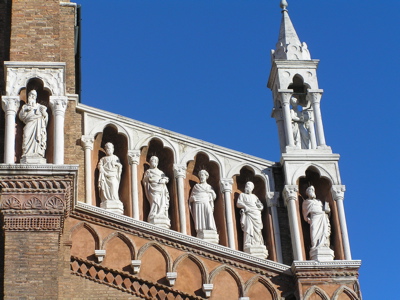
Around
Cannaregio

 |
Around
Cannaregio
|
 |
| Along
with the sestieri of San
Marco and Castello, Cannaregio is located to the north and east of the
Grand Canal, which in the vernacular used to be called de citra ("near side" of the Grand
Canal). Cradle of artists and explorers, Marco Polo, Wagner, Tintoretto
and Titian found a home in Cannaregio. The
name Cannaregio is derived from the reeds (canna) that used to grow on the
shores of the canals. The reeds -long gone- were replaced by a
rich and diverse cultural and commercial life that survives even today.
The Strada Nova, a new street, that spans almost the whole length of
the sestiere, connecting San
Marco with the Ferrovia, is the heart of Cannaregio. Its soul, however,
can be found in the back canals and hidden campi, the Jewish ghetto and the
church of the Miracoli. |
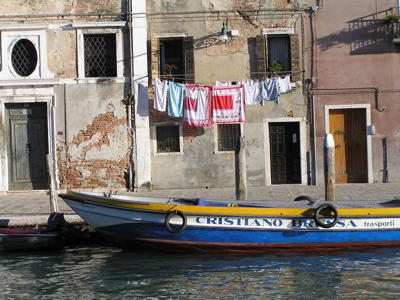 |
 |
| We
begin our tour where we ended it at San Marco, on Ponte de l'Olio. In
front of us and to our right is the only department store in Venice, Coin,
which occupies several floors of a Gothic Palazzo. This department
store epitomizes the old Venetian mercantile spirit. Born in the Veneto
at the beginning of the XX century, Coin
has now branches all over Italy. We take Salizada San Giovanni
Grisostomo; to our left is an emblematic pasta shop, Pastificio Rizzo, Cannaregio 5778,
where you can find not only an assortment of artisanal pastas with
unique textures and flavors -for example the multicolored Arlecchino
Pasta or the striped Rainbow Bowties that will take you back to Venice
whenever you cook them at home- but also staples from faraway corners
of the world, from Argentinian dulce
de leche to American cranberry juice. We make a right turn on
Calle de l'Ufizio de la Seda (Street of the Office of Silk), on the
side of the church San Giovanni Grisostomo, and soon turn right
again on Calle del Cagnoletto. We turn left on Calle Morosini that
leads to beautiful Corte Morosini. The mossy courtyard with two
uncovered staircases, a XIV-century wellhead and Gothic windows is one
of the most enchanting corners of Venice. |
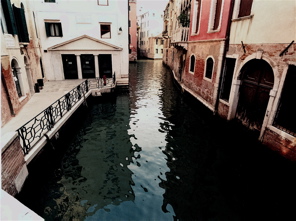 |
We
retrace our steps to Calle de l'Ufizio de la Seda and go under the sotoportego to Corte
1º del Milion that leads to Corte 2º del Milion. These courts
take their names from Marco Polo's Il
Milione,
an account of his travels to the Far East that he dictated while in
prison. Marco Polo (1259-1323) was born and lived in the area now
occupied by the
two courts and the Teatro Malibran. Remains of very old
Veneto-Byzantine architecture (XI and XII cent.) are still visible in
Corte 2º del Milion. The location of Marco Polo's house can be
seen from the middle of Ponte Marco
Polo, looking into the entrance of the theater.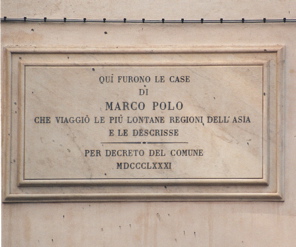 |
| We
make our way back to the church of San Giovanni Grisostomo. A beautiful
Bellini, Saints Jerome, Christopher
and Louis can be admired in one of the side altars. This is how
Henry James describes the painting: "...
one of the very few (Bellinis)
in which there is no Virgin...a St. Jerome, in red dress, sitting aloft
upon the rocks, with a landscape of extraordinary purity behind
him...it has a brilliant beauty, and the St. Jerome is a delightful old
personage." The high altar boasts Sebastiano del Piombo's St. John Chrysostom and Six Saints. The
three female saints to the left of San Giovanni Grisostomo are also
described by James: "These ladies
stand together on the left, holding in their hands little white
caskets; two of them are in profile, but the foremost turns her face to
the spectator. This face and figure are almost unique among the
beautiful things of Venice, and they leave the susceptible observer
with the impression of having made, or rather having missed, a strange,
a dangerous, but most valuable, acquaintance." A magnificent
marble altarpiece by Tullio Lombardo, The
Coronation of the Virgin, graces another side altar. As we leave
the church, we continue on the salizada
in the opposite direction we
came in. We cross the bridge over Rio de San Giovanni Grisostomo and
cut across Campielli F. Corner and Riccardo
Selvatico and come to the picturesque Sotoportego Falier where we make
a left turn. |
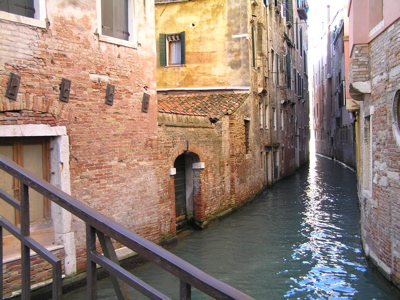 |
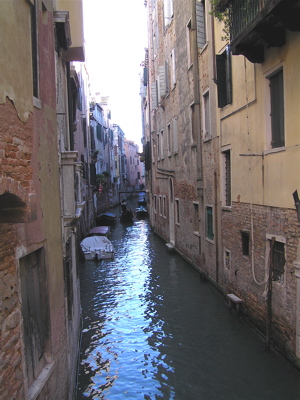 |
|
Rio de S. Giovanni Grisostomo (towards the Grand Canal) |
Rio de S. Giovanni Grisostomo (towards R. dei Miracoli) |
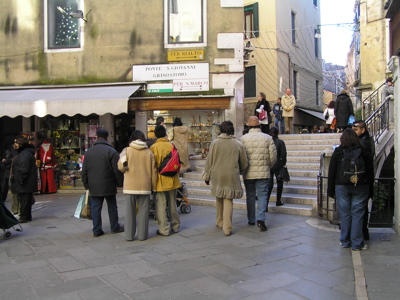 |
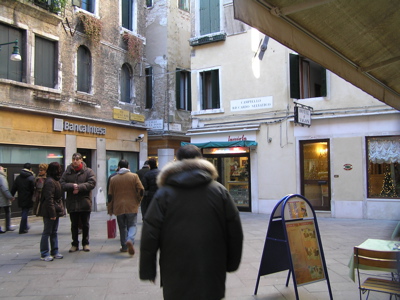 |
| Campiello F.
Corner |
Campiello
Riccardo Selvatico |
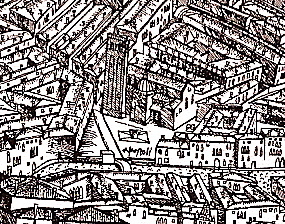 |
By
the Santi Apostoli bridge, half on land and half on water, there is a
shop that was already there in the year 1500 as shown in Jacopo de'
Barbari's masterful rendering of Venice. 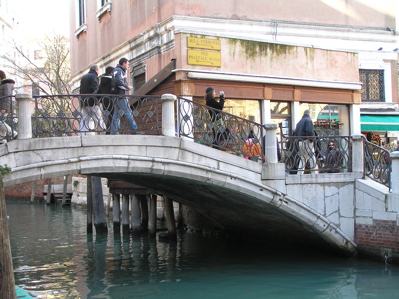 |
| We cut across Campo Santi Apostoli and take Salizada del Pistor. We turn right at the third intersection, Rio Terà dei Franceschi. On the left-hand side is Cinema Giorgione, the last operating movie theater in Venice. We turn left on Rio Terà Santi Apostoli on the side of the theater, and then right at the second intersection, Rio Terà Barba Frutariol. We cross Ponte Giustinian into Calle de la Madona and walk to the end, Calle Morandi, where we turn right. At the end of Calle Morandi is Calle Varisco, the narrowest street in Venice, spanning only 53 cm. If you walk by the intersection of Calle Varisco and Calle Bandi, in the early morning you would be delighted with the sweet smell of orange-blossom water coming from the ovens of a nearby bakery. |
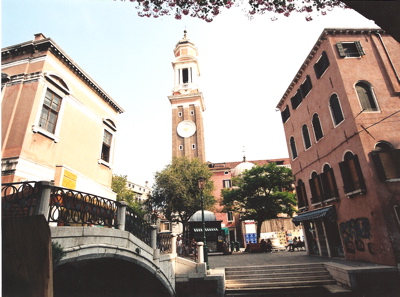 |
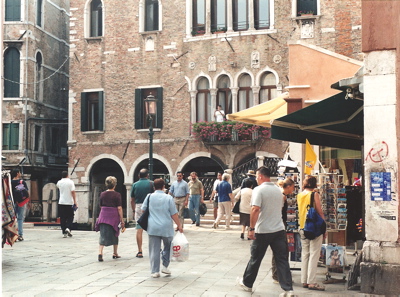 |
| Campo Santi
Apostoli from Sotoportego Falier |
Campo Santi Apostoli |
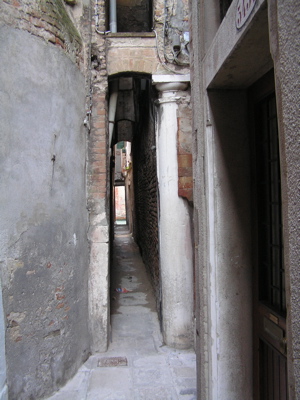 |
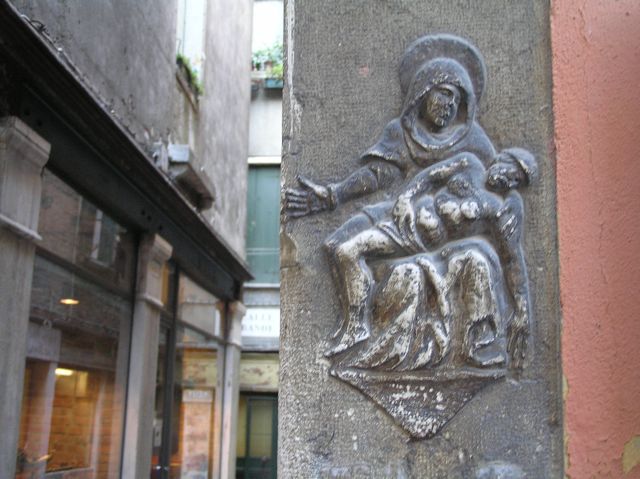 |
| Calle Varisco |
Pietà at Calle del Pestrin,
off Varisco |
| From
Calle Varisco we continue to Calle del Pestrin where a beautifully
shaped wellhead sits under the protective shade of verdant vines. A
moving Pietà is
carved on the corner pillar. As we
cut across campiello Stella and then Campiello Widmann we may see canoce, a delectable Venetian
crustacean, and other tempting sea creatures waiting on ice to become
somebody's meal. |
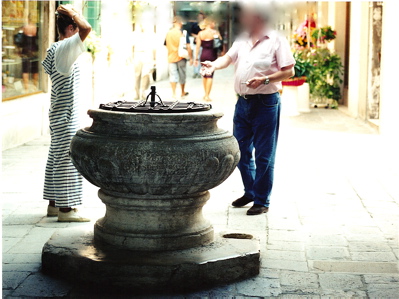 |
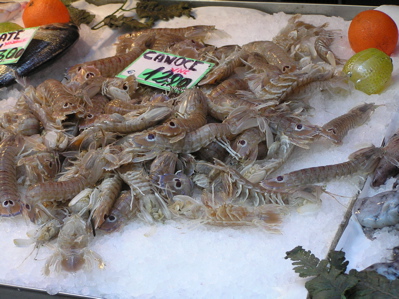 |
| Wellhead on
Calle del Pestrin |
Fresh canoce |
| We
take Calle Widmann at the other end of the campiello to the fondamenta and sotoportego of the same name, where
we make a left turn. The beautiful church of the Miracoli will soon be in view as we
reach Ponte del Piovan at the end of the sotoportego. The Church Santa Maria
dei Miracoli is one of the best kept secrets of Venice. Tucked away in
this quiet corner of Cannaregio, this jewel-box of a church is a
favorite with Venetian brides but is visited only by the determined
tourist. It was built between 1481 and 1489 from a design by Pietro
Lombardo, the same architect that designed the beautiful Ca' Dario on
the
Grand Canal. It is one of the few free-standing churches in Venice
-another one being San Zulian in the sestiere
di San Marco- and the
only one completely clad in marble, probably leftovers from the
Basilica di San Marco. Multicolored marbles from Carrara, Verona and
the Eastern Mediterranean were used in its construction. The interior
of the church boasts an unusual elevated altar where the miraculous
image of the Virgin and Child, to which the church is dedicated, is
honored. A magnificent coffered ceiling and splendid sculptures and
carvings by Tullio Lombardo -Pietro's son- complete the picture. The
church was recently painstakingly restored by the American committee Save
Venice. |
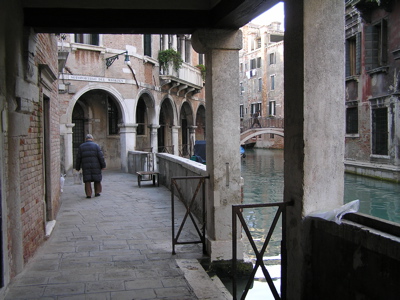 |
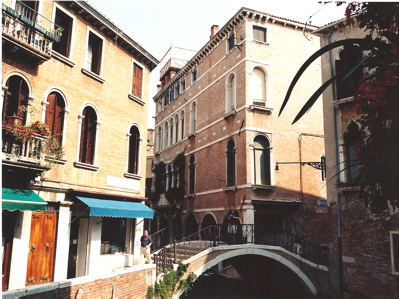 |
| Sotoportego
and Fondamenta Widmann |
Fondamenta
and Ponte del Piovan |
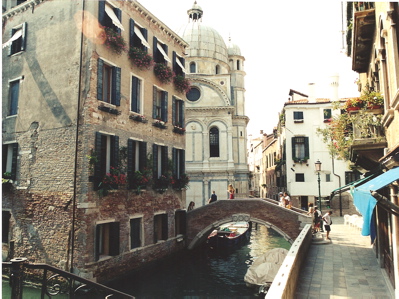 |
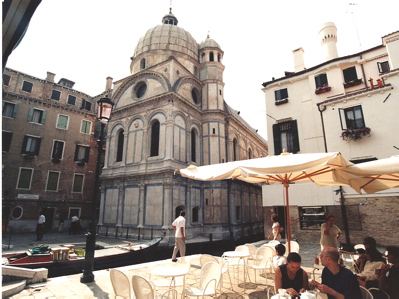 |
| Church
of the Miracoli from Fondamenta del Piovan |
Campo Santa
Maria Nova and Campiello dei Miracoli |
| Before
or after visiting the church we must stop for a cup of coffee at Bar Ai Miracoli on Campo Santa
Maria Nova. This is one of my
favorite cafes in Venice. In summertime, sitting outside you will enjoy
the company of the locals gathered under the protective shade of the
trees. In wintertime, you can curl up in one of the cozy booths by the
back window with a magnificent view of the canal and the church. The
owners are very friendly and although the atmosphere is always vibrant,
you can stay there undisturbed for hours just reading or writing. A
stroll around the campo will reveal an interesting collection of
stores: a bookstore that also sells old prints, an antique store, and
one of the three stores of Paolo
Olbi, bookbinder, where it's likely that Paolo himself will help
you choose a beautifully handbound journal. Across from the canal, at
the back of the church, is Campiello dei Miracoli. You may recognize it
from the movie "Bread and Tulips",
but don't look for the flower shop; it does not exist. |
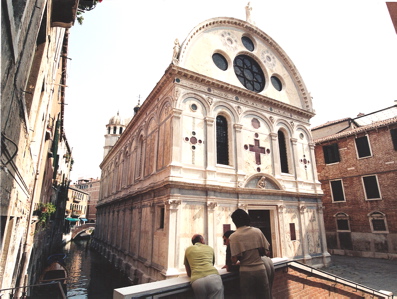 |
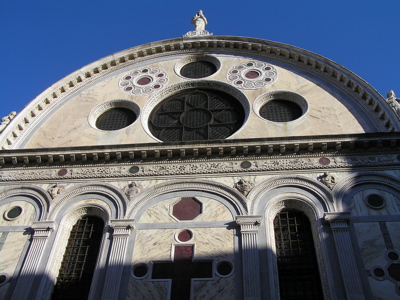 |
| Santa Maria
dei Miracoli |
Santa Maria dei Miracoli |
| If you are lucky, you may visit the area when the children from the kindergarten next to the church are taken out by the nuns for a midmorning stroll around Venice, and you may wonder: how does it feel to grow up surrounded by so much beauty? |
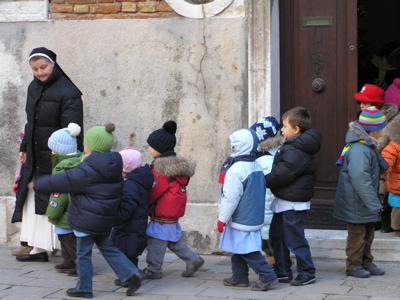 |
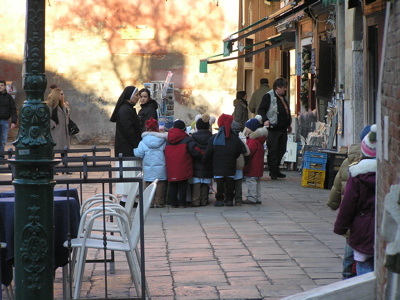 |
| We take the side street, Calle Fianco la Chiesa and turn left at the end, Calle Castelli, as we reach the next canal, Rio de la Panada, Palazzo Soranzo-Van Axel will be to our left at the end of Fondamenta de le Erbe. The wooden door dates from the XV century and is unique in Venice. It still has the original metal knocker, a dolphin, and intricate carvings. Many movies were shot with this palazzo as a backdrop, most recently Casanova. |
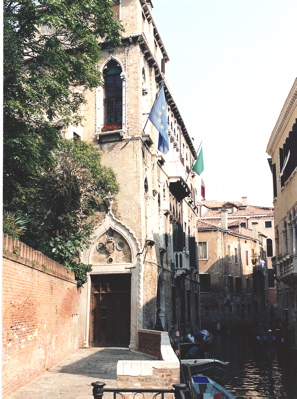 |
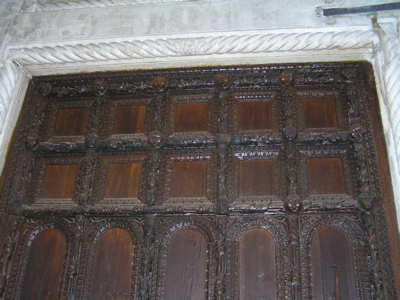 |
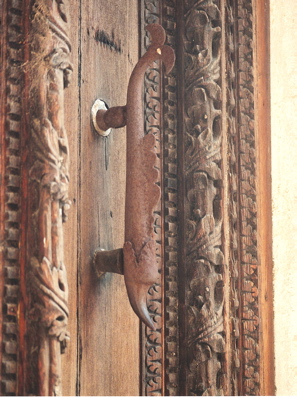 |
| Palazzo
Soranzo-Van Axel |
Portal
detail |
Knocker |
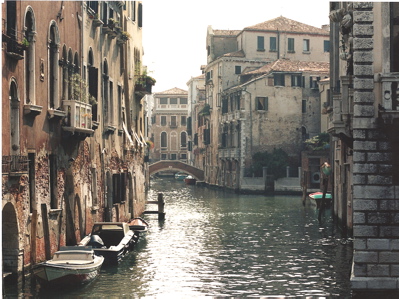 |
We walk to the other end of the fondamenta, to Ponte del Cristo where the Venice of our dreams gets easily confused with the real one in the ever-changing reflections of the canal. |
| We retrace our steps to the front of the church, Campo dei Miracoli, cross the bridge and take Corte dei Miracoli to Campiello Santa Maria Nova. We make a left turn at the first intersection and we will soon be in front of the church of San Canzian. We cross the bridge and then cut across Campiello de la Cason (Cason is an old term for prison) to Calle del Manager that takes us behind the church and campo of Santi Apostoli where Strada Nova begins. This street was opened in the second half of the XIX century. No other street in Venice is wider, longer or with less character. Still, many things along the way are worth seeing. For example, the view of Ca' da Mosto, one of the oldest palaces on the Grand Canal dating from the XI century, is unsurpassed from Ramo Dragan off the Strada Nova a few meters away from Campo Santi Apostoli. |
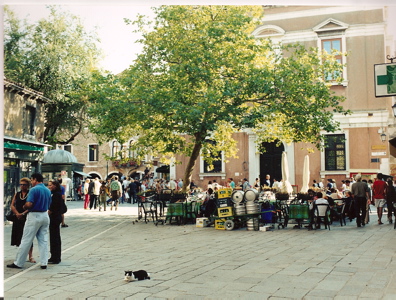 |
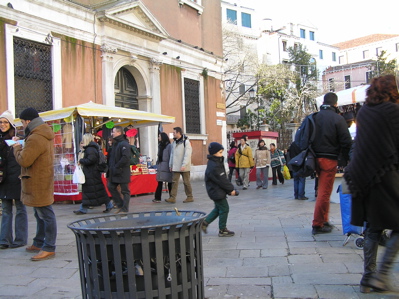 |
| Campo
Santi Apostoli |
Beginning
of Strada Nova |
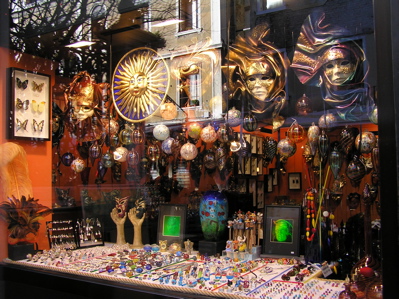 |
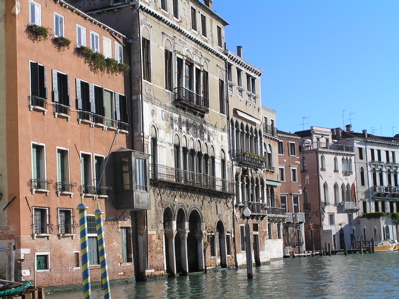 |
| Shop
on Strada Nova |
Ca' da Mosto
from Ramo Dragan |
| From
Campo Santa Sofia the view of the Pescaria (Fish Market in the Rialto
district) and the Fabriche Nove is superb, more so after a snowstorm. |
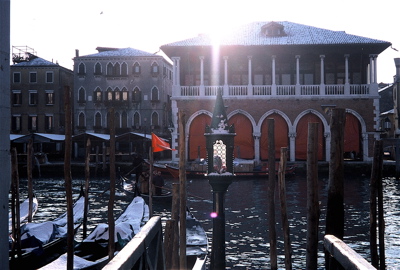 |
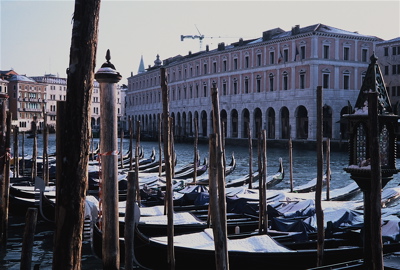 |
|
The Pescaria from Campo Santa Sofia |
Fabriche Nove from Campo Santa Sofia |
| The
Ca' d'Oro
(Golden House) is off Strada Nova just past Campo Santa Sofia. Now a
museum, the house was built in the early XV century and it once boasted
a gilded façade. By the beginning of the XIX century it had
fallen into complete disrepair. It underwent a careless restoration
that almost destroyed it but it was brought back to its previous glory,
albeit without the glitter, by the intelligent restoration commissioned
by Baron Giorgio Franchetti who donated it, along with a vast art
collection, to the state in 1916. It is now, as it once was, one of the
most beautiful buildings in Venice. It houses wonderful paintings by
Carpaccio, Vivarini and Tintoretto and sculptures by Tullio Lombardo
and Bernini among many others. The best time to admire the
façade of Ca' d'Oro is after a rain, when the polychrome marbles
deepen their colors. In the words of Horatio Brown, "There are two
moments particularly favourable for an artist to take his walks in
Venice. One is after a rain shower, when the old intonaco upon the walls has every
tone brought out, and is vivid with colour ranging from grey through
pale sea-green to red -the old Venetian red with which so many houses
used to be stained. The other choice moment for a walk is in the early
morning before the business of the day has begun." Just past Ponte Novo San Felice is Calle del Traghetto. At the end of this street, by the Grand Canal, engraved in a massive column belonging to Palazzo Contarini-Pisani is a bas relief of a rat, unusual homage to a most despised animal, especially in a city where so many died because of the plague carried by this rodent. The oldest pharmacy in Venice is also on the Strada Nova, Cannaregio 2233a, right across from the church of Santa Fosca. The old apothecary room decorated with majolica vases and beautifully carved walnut furniture can be admired from the room next door in the Farmacia Santa Fosca all'Ercole d'Oro. |
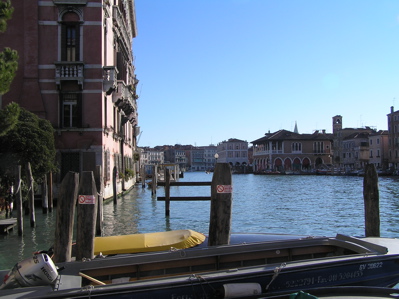 |
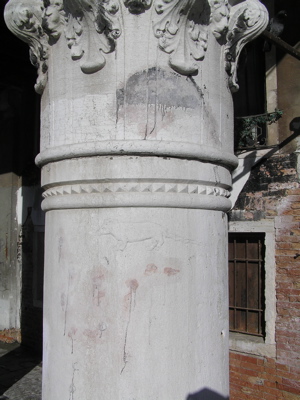 |
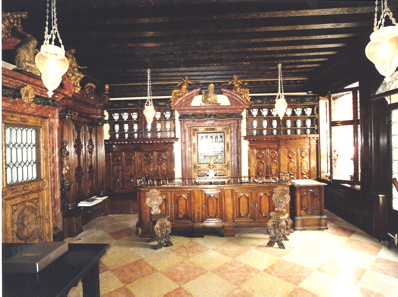 |
| View from
the dock at the end of Calle del Traghetto |
Monument
to the Rat |
Oldest
pharmacy in Venice |
| A
couple of things are worth seeing in campo Santa Fosca. One is the
statue of Fra Paolo Sarpi (1552-1625) a scientist and theologist who is
credited with discovering the dilation of the iris and making the first
map of the moon. However, he is better remembered in Venice as a
patriot who stood against Rome in defense of his city when Pope Paul V
excommunicated everyone in Venice. His arguments were so well founded
that the Pope finally conceded to Venice. An attempt to assassinate him
took place soon after, but Fra Paolo, as he was known, miraculously
survived and recovered. His comment on the wounds received was "I
recognized the style of
Rome," making double reference to the style of the Roman Church and the
stiletto knife used in the attack. He lived for another eighteen years
in his Servite cloister. The other point of interest in Campo Santa Fosca is the bridge behind the statue. It is called Ponte Santa Fosca, but it was once known as Bridge of the War, Ponte della Guerra, because of the fist fights staged on this bridge between rival groups. Marble footprints inlaid on the paving of the bridge indicate the initial positions for these fights. |
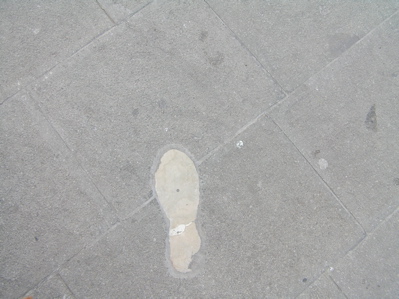 |
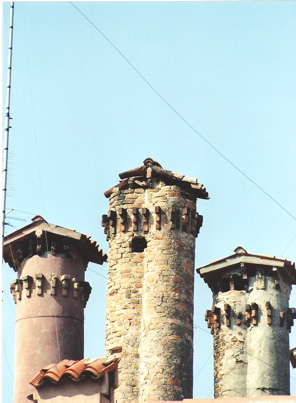 |
| After
crossing Ponte S. Antonio, to our left is Campo de la Madalena, a
beautiful corner of the city with typical houses and charming old
chimneys. A little further up on Rio Terà de la Madalena (the
continuation of the Strada Nova in this part of Venice) is Calle Larga
Vendramin where we make a left turn. At the end is the back entrance to
Palazzo Vendramin-Calergi where the Venice Casino operates (except for
the summer months when it moves to the Lido). This is also the place
where Richard Wagner lived and died in 1883. |
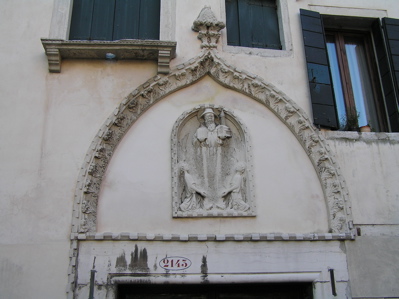 |
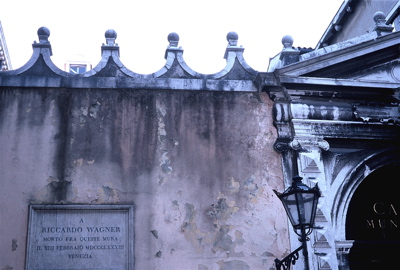 |
|
Gothic Portal, Palazzo Magno, C. de la Madalena |
Back entrance to Palazzo Vendramin |
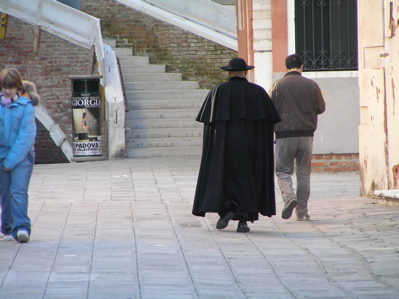 |
We
leave Campiello Vendramin by the exit that connects to Campiello
Colombina; we continue on to Ramo and Fondamenta Colombina from where
there is a nice view of Ponte Storto (Crooked Bridge) and the rio and church of San Marcuola, a
hybrid saint. In typical Venetian fashion, the name Marcuola doesn't
refer one saint, but rather two: Ermagora and Fortunato. How these two
names evolved and fused to become one is anybody's guess, but other
examples abound. The church of San Trovaso, in Dorsoduro, is dedicated
to Saints Gervasio and Protasio, and the church of San Zanipolo, in
Castello, to Saints Giovanni and Paolo. Left: Behind the church of San Marcuola. |
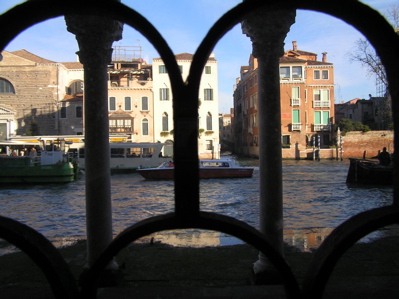 |
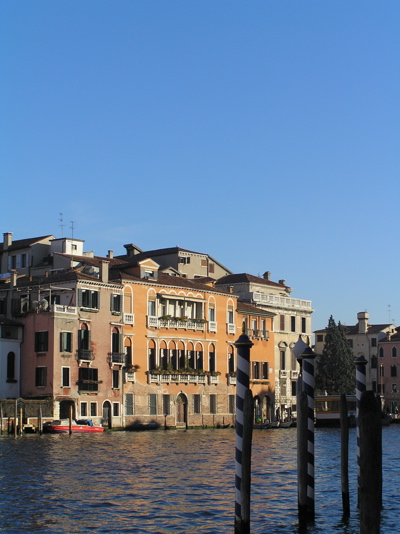 |
| Grand Canal
with Rio de S. Marcuola from Fontego dei Turchi |
Palazzo
Gritti-Dandolo and Ca' Memmo-Martinengo (behind) |
| Next
to the church of San Marcuola is Ca' Memmo-Martinengo. Here is where
Andrea Memmo, Procurator of Saint Mark, friend of Casanova, passionate
lover of Giustiniana Wynne lived and died. His life and tumultuous
affair with Giustiniana have been recently recounted in the wonderful
book A Venetian Affair by Andrea di Robilant. We take Rio
Terà del Cristo to the intersection of Rio Terà San
Leonardo with Calle del Pistor and Rio Terà Farsetti and take
the latter. At the first intersection on our left, we turn on
Callesele. This street will take us to Calle Gheto Novissimo, one of
the entrances to the Jewish Ghetto. The word ghetto derives from the Venetian
word getar, meaning "to
cast." The area was known as the geto
at San Hieronimo
(San Girolamo) because of the public foundries where primitive cannons
were cast. A Senate decree of 1516 created the first Jewish ghetto, the
Gheto Novo, forcing about seven hundred Jews already living in Venice
to move to this location. The ghetto was entirely walled and closed at
night; the Jews were allowed to move freely around the city only during
the daytime. In 1541 the Gheto Vechio, separated from the Gheto Novo by
a bridge, was created. There are still five synagogues, called Scuole, in the
ghetto; three in the Gheto Novo: German, Italian and Canton, and two in
the Gheto Vechio: Spanish and Levantine. Some of them can be visited
through the Museo Ebraico
located on the Campo de Gheto Novo. The synagogues are nondescript on
the outside but lavishly decorated on the inside. They can be
recognized from the street because their façades usually display
five identical windows, representing the five books of the Torah. |
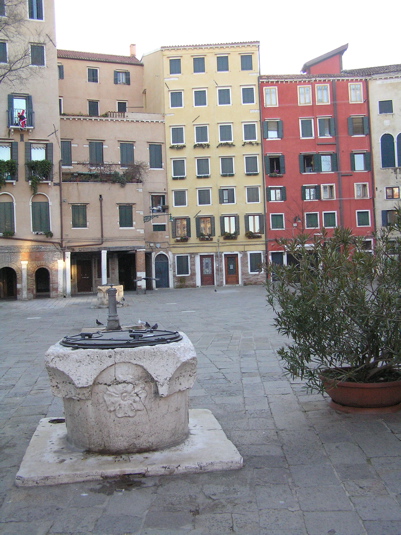 |
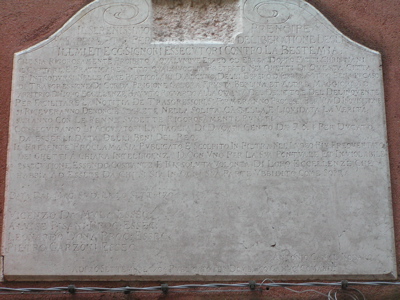 |
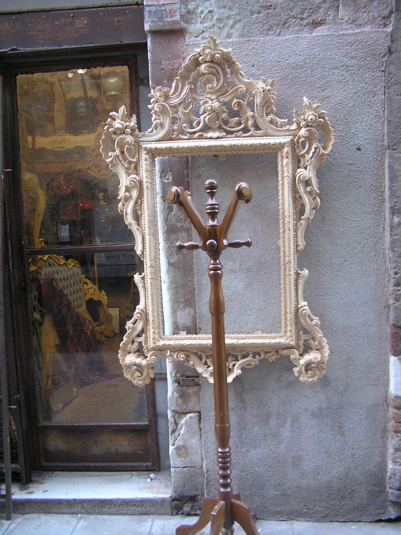 |
| Campo de
Gheto Novo |
Tablet in
Gheto Vechio, Cannaregio 1131 |
Artisan's shop in the Gheto Vechio |
| As
the population of the ghetto increased, so did the demand for housing,
which resulted in the construction of taller and taller buildings, like
the seven-story apartment house still standing today in the Gheto Novo.
At the beginning of the XVIII century the Officers of the Republic
posted a stone tablet in the middle of the Gheto Vechio warning Jews
who had converted to Christianity not to enter the private houses of
other Jews or suffer the consequences (whip, prison, galleys). The
carving of the lion of Saint Mark on top of the tablet was removed,
presumably by the Jews, at the fall of the Republic in 1797. No more
than 200 Jews live in the ghetto today but the place still retains many
of its old traditions; there are regular services at the synagogues and
bookstores, crafts stores, bakeries and kosher restaurants cater to the
local and international Jewish community. One of my favorite stores is Shalom da Venezia that specializes
in Jewish art, Cannaregio 1219. |
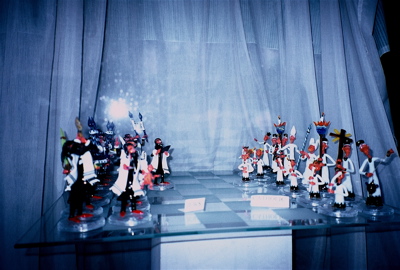 |
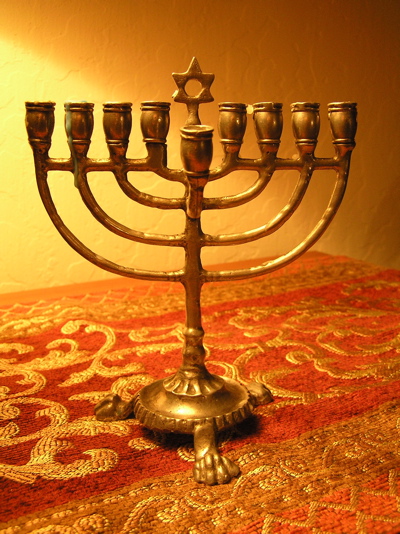 |
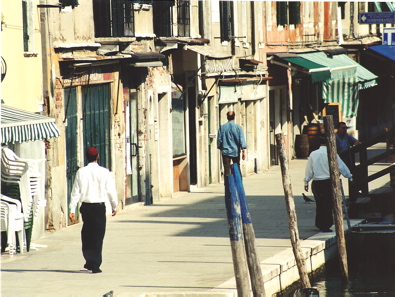 |
| Catholics
vs. Jews, chess version |
A menorah
from Shalom Venezia |
Fondamenta
de Cannaregio near the ghetto |
| We
exit the ghetto through the sotoportego
at the end of Calle del Ramo Gheto Vechio that leads to Fondamenta de
Cannaregio. We turn left, cross the bridge with the four obelisks,
Ponte de le Guglie, and continue straight ahead to Campo San Geremia.
The church of San Geremia and Santa Lucia will be on our left. Santa
Lucia, virgin and martyr, was originally from Siracusa, Sicily. She is
the patroness of gondoliers and eye doctors. Legend has it that she
plucked her eyes out and presented them to her suitor who in a fit of
rage had denounced her to the authorities for being a Christian when
she refused his proposal so she could consecrate her life to God. Her
feast day is December 13, the winter solstice in the old Julian
Calendar. Since her name Lucia
means "light", one may wonder whether it is a coincidence or not that
her day fell on the shortest day of the year that always brings the
promise of the renewal of light. Dressed in red and wearing a mask, her
body is on display inside a crystal casket in the church. The feast of Santa Lucia is very dear to the Italians (and also to the Scandinavians) who celebrate it according to local traditions that vary from place to place. In North-Eastern Italy, Saint Lucy brings gifts to the well-behaved children and coal to those who misbehaved. The other saint to whom the church is consecrated, San Geremia, was never canonized by the church. But he is not alone; neither were San Moisè and San Giobbe (Job) for that matter, being all biblical figures from the Old Testament but that did not stop the Venetians from building them churches. From the church we take Lista di Spagna that leads us to the third bridge on the Grand Canal, Ponte dei Scalzi (scalzi meaning "barefoot") which takes its name from the church nearby. A few steps away is the Ferrovia or Stazione Santa Lucia. Here is where the old church of Santa Lucia once stood, until it was demolished to make room for the train station. If we continue on the fondamenta along the Grand Canal we will see the fourth bridge, designed by the Spanish architect Santiago Calatrava. After some delay, it finally opened in 2008. It connects the Ferrovia area with Piazzale Roma and it feels right at home. Its sleek design elevates one of the ugliest districts of Venice (if Venice can have any ugly district) and brings the 21st century to this corner of the city. |
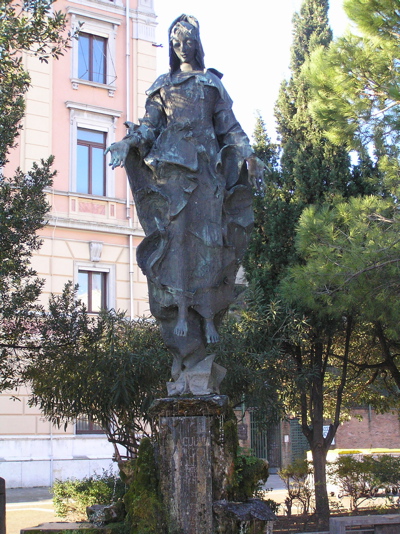 |
Left:
Statue of Santa Lucia by the train station.
Below: The pillars of the Calatrava bridge on the Cannaregio side, under construction in 2005. 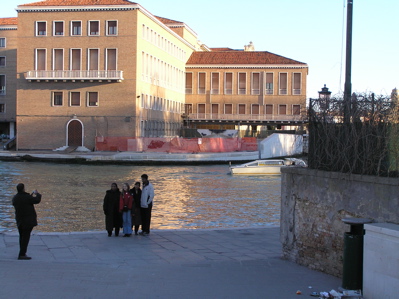 |
Below:
Details about the Calatrava bridge.
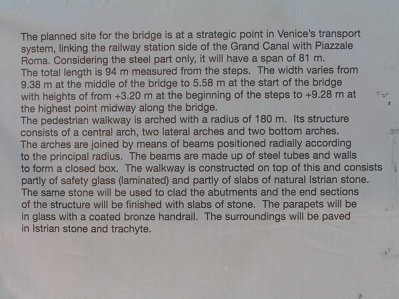 |
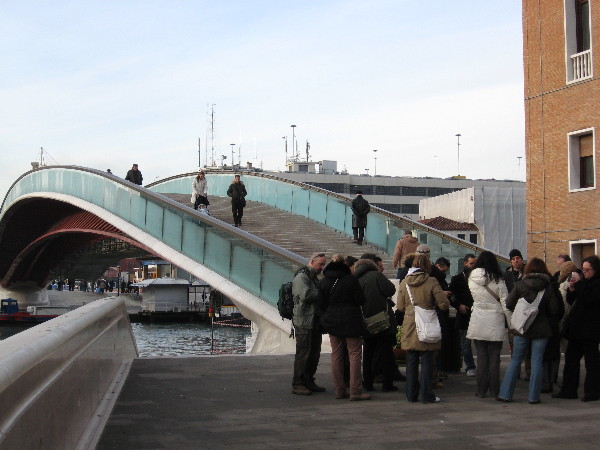 |
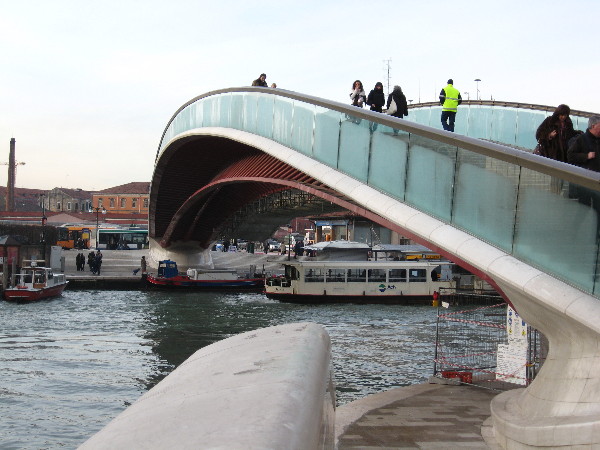 |
| We
return to Ponte de le Guglie via Lista di Spagna where we can stop for
a coffee and some awesome pastries at Pasticceria
Dal Mas (Cannaregio 150a), one of the best pastry shops in
Venice; my choice is usually a Pavana,
a sweet roll with delicious candied fruit. We take the long and quiet
Fondamenta Savorgnan, along the Canal de Cannaregio, that soon changes
its name to San Giobbe. My favorite time to walk along this canal is on
a sunny Sunday morning when the bells of the church of San Giobbe
incessantly call the faithful to mass. We can see old matrons, arm in
arm, slowly walking towards the church while commenting on the latest
gossip. A lonely lady, still half asleep, taking her dogs for an
early morning walk; a young housewife hanging a huge tablecloth to dry
out of a second-story window -an evocation of a Saturday evening well
spent around a delicious meal in the company of friends and family; a
crew of city workers trying to fix a broken pipe. This is Venice at its
best. |
 |
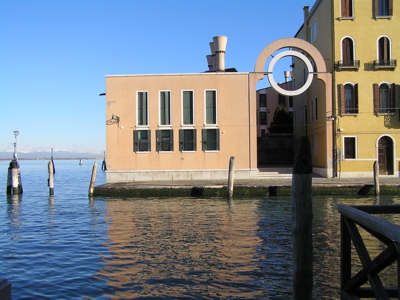 |
| At
the end of the fondamenta, is the Chiovere
de San Giobbe, also called the Saffa,
a former industrial district of Cannaregio that used to have a
slaughter house, butchers, a mill, and dyers. The word chiovere
was used to describe the fields where fabrics were left to dry after
dyeing. All that remains of that enterprise today is a few houses with
a front garden, a rarity in Venice, and the colorful names of the
streets: Calle del Scarlato, Calle del Verde, Calle dei Colori,
Campiello de la Grana. At the end of the Canal de Cannaregio, there is
an amazing view of the lagoon and the mountains. |
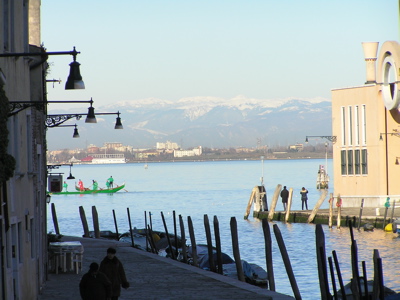 |
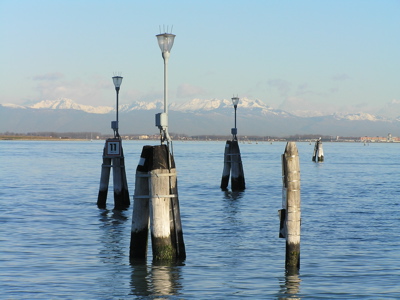 |
| We
cross the Canal de Cannaregio by Ponte dei Tre Archi (Bridge of the
Three Arches) turn left on Fondamenta de Cannaregio and then right on
the first sotoportego, Calle
de le Cooperative. We turn right at the end and walk along the canal,
Rio de Ca' Moro, to the tip of the island. On a clear winter day the
view of the snow-capped Dolomites is breathtaking. No many visitors to
Venice realize how close the mountains are, and not many places in
Venice offer a better view of them. The benches along the fondamenta
are an invitation to a quiet contemplation. Bring a book and enjoy. |
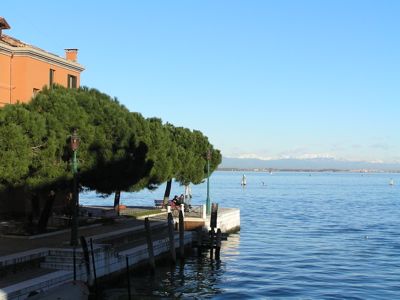 |
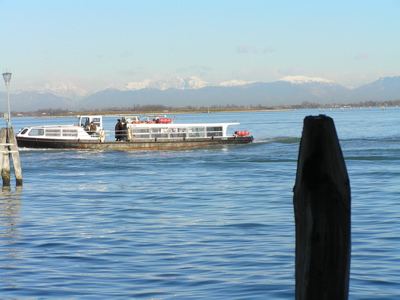 |
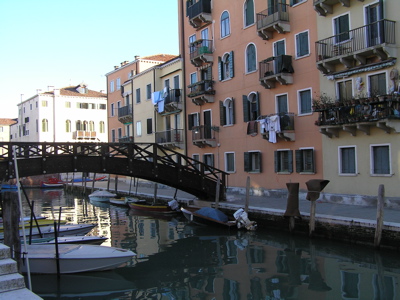 |
We
cross the wooden Ponte Novo to Chiovere de San Girolamo; a relatively
new housing development occupies most of the island. We walk on
Fondamenta S. Girolamo along the canal and then cross Ponte San
Girolamo and make a right turn on the Fondamenta dei Ormesini. We will
soon pass to our right the Ponte de Gheto Novo; the next intersection
is Calle de la Malvasia where we make a left turn. We soon reach Rio de
la Sensa which we cross by Ponte de la Malvasia and continue straight
ahead to Calle del Capitelo. This will lead us to Campo San Alvise. The
church of San Alvise (Saint Louis, Bishop of Tolosa) will be to our
right. The church has some interesting pictures that were once
attributed to Carpaccio, until they were dated to a time when Carpaccio
was only a boy, and that's why they are now sarcastically known as
"Baby Carpaccios." Campo San Alvise is lovely; it has benches that
invite us to relax in one of the most remote and tranquil corners of
Venice. |
| On
one side of the Campo San Alvise is Fondamenta dei Riformati at the
end of which is a psychiatric hospital Umberto 1º. From the Ponte
de San Bonaventura there is a lovely view of Rio dei Riformati and the
lagoon. |
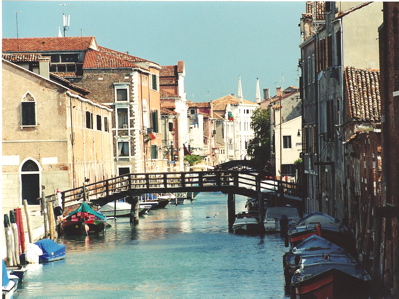 |
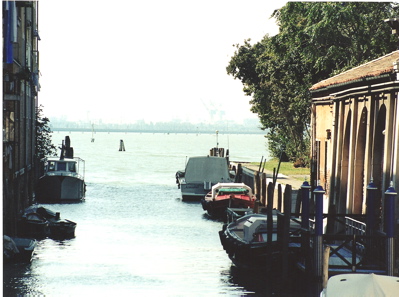 |
| Campo and
Ponte S. Alvise |
Rio dei Riformati |
| We
retrace our steps to Rio de la Sensa and walk along the fondamenta to
Campo dei Mori. This is an enchanted place. The statues of three Moors,
plus their servant, seem to come alive from the walls of the buildings.
According to legend the three Moors are the Mastelli brothers (Rioba,
Sandi and Afani) who came to Venice from Morea (Peloponnese) and owned
a palazzo around the corner, on Rio de la Madonna de l'Orto, known as
Palazzo Mastelli or del Cammello (of the Camel). The appellative Moors seems to refer to the fact
that the brothers were from Morea,
and not from North Africa as the term Moor usually indicates. The
statue with the iron nose is very popular in Venice and it's known as
Sior Antonio Rioba. |
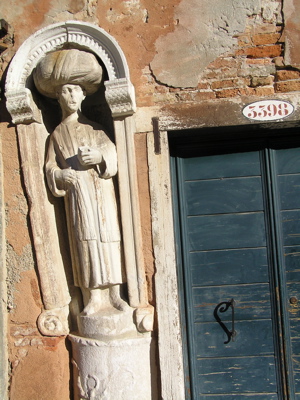 |
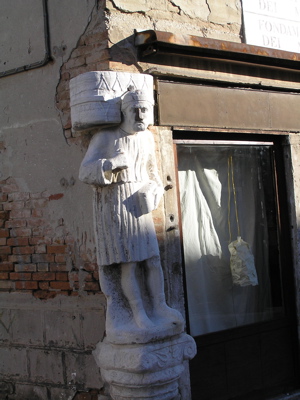 |
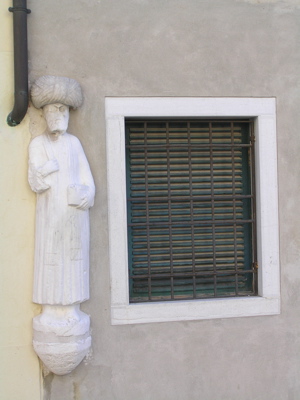 |
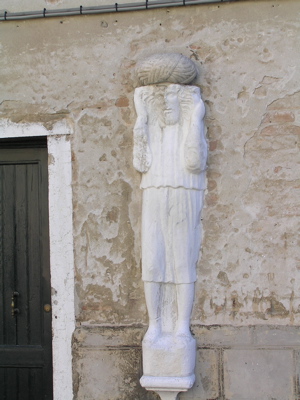 |
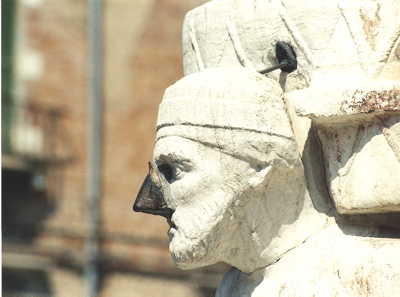 |
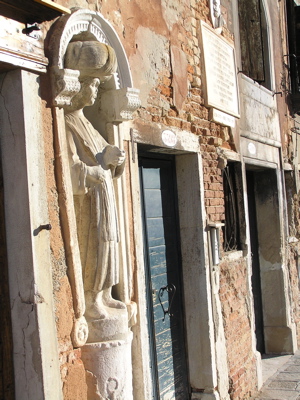 |
| A
few steps away on Rio de la Sensa is the house of Tintoretto. Here the
Venetian painter Jacopo Robusti, better known as Il Tintoretto, lived from 1574
until his death twenty years later. He is buried in his favorite
church, Madonna de l'Orto, where many of his paintings can be admired. |
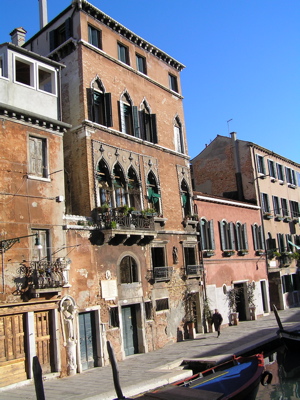 |
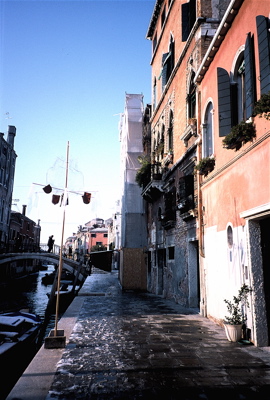 |
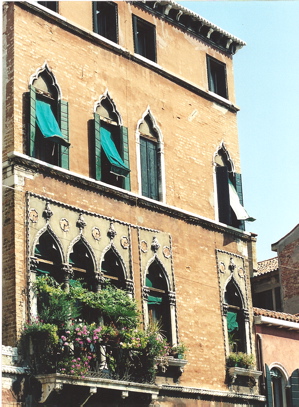 |
| House of
Tintoretto |
Rio de la
Sensa and Fondamenta dei Mori in winter |
House of
Tintoretto |
| The
church of Madonna de l'Orto is named after an ancient miraculous statue
of the Madonna found in a nearby garden (orto). Its first patron was Saint
Christopher (San Cristoforo) protector of gondoliers and wayfarers, a
statue of which can still be seen on top of the main portal, probably a
work of Bartolomeo Bon. Next to the church is the Scuola dei Mercanti.
A beautiful image of the Madonna
della Misericordia graces the portal. |
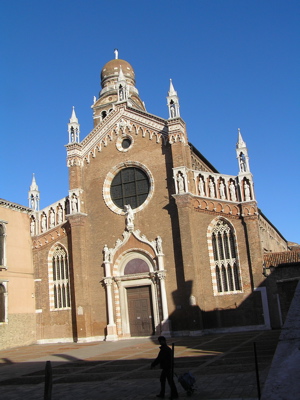 |
 |
| Church
of Madonna de l'Orto |
Madonna
de l'Orto, detail |
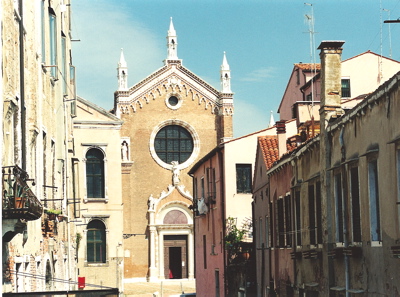 |
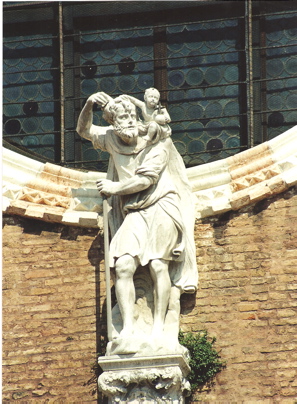 |
| Madonna
de l'Orto from Fondamenta dei Mori |
San
Cristoforo |
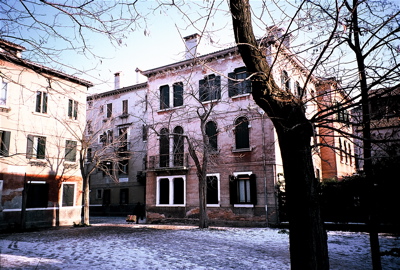 |
Behind the church is Campiello Piave, a cozy corner of Venice with attractive apartment buildings surrounded by gardens. The view of the church's bell tower with its characteristic onion-shape top is superb. A few steps away is the Madonna de l'Orto vaporetto stop and an incredible view of the lagoon and the island of Murano. |
| We
go back to Rio de la Madonna de l'Orto where we can admire the Palazzo
Mastelli or del Cammello (because of a relief of a camel, carrying a
huge load, on its façade). One canal down, on Rio de la Sensa by
Campo dei Mori there is a
building with a water gate displaying some typical Venetian ironwork.
The same intricate lace-like design can be admired in a metal ruler
from the Peggy Guggenheim collection (2001). |
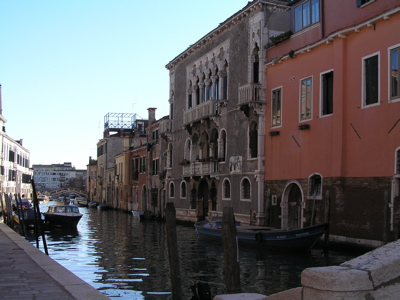 |
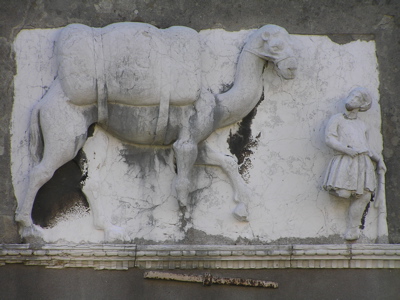 |
| Rio de la
Madonna de l'Orto with Palazzo Mastelli |
Detail of Palazzo Mastelli |
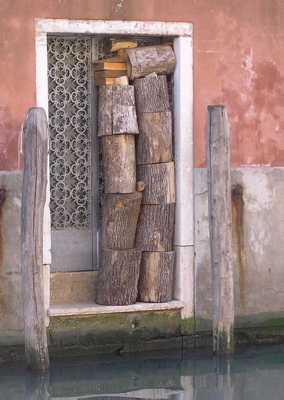 |
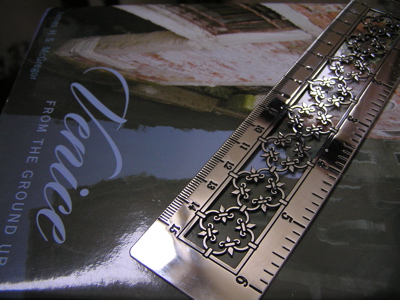 |
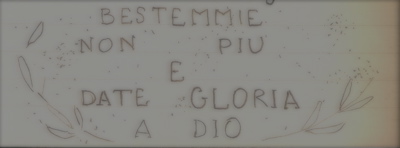 |
Before
we leave the area we cross Ponte dei Mori and walk a few steps down
Calle Larga. On the wall, by the number 2554, right across from a small
tabernacle there is an inconspicuous and worn out tablet that reads
"BESTEMMIE NON PIU E DATE GLORIA A DIO" (Curse no more and give glory to God)
and one cannot help but wonder what possessed the installer of the
tablet to put up such a commandment in this remote corner of Venice; a
gang of unruly teenagers? |
At the end of Calle Larga we make a left turn on Fondamenta de la Misericordia and walk along the canal. We are about to leave this part of Cannaregio where the canals are impossibly straight and the atmosphere quaint and unhurried, but before we do, we should take a look at Palazzo Lezze with its strange alchemical carvings. 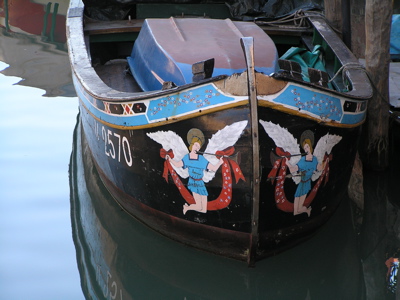 |
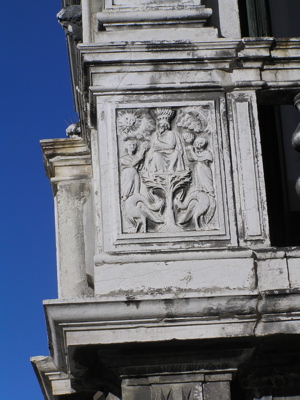 |
| We
cross Ponte de la Misericordia, next to the Scuola Nova della Misericordia,
the next bridge is the romantic Ponte Chiodo, the only remaining bridge
in Venice without parapet. We turn right on Fondamenta San Felice that
will take us back to Strada Nova and the end of our tour of Cannaregio. |
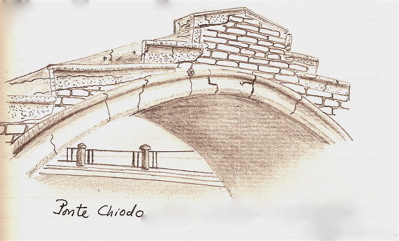 |